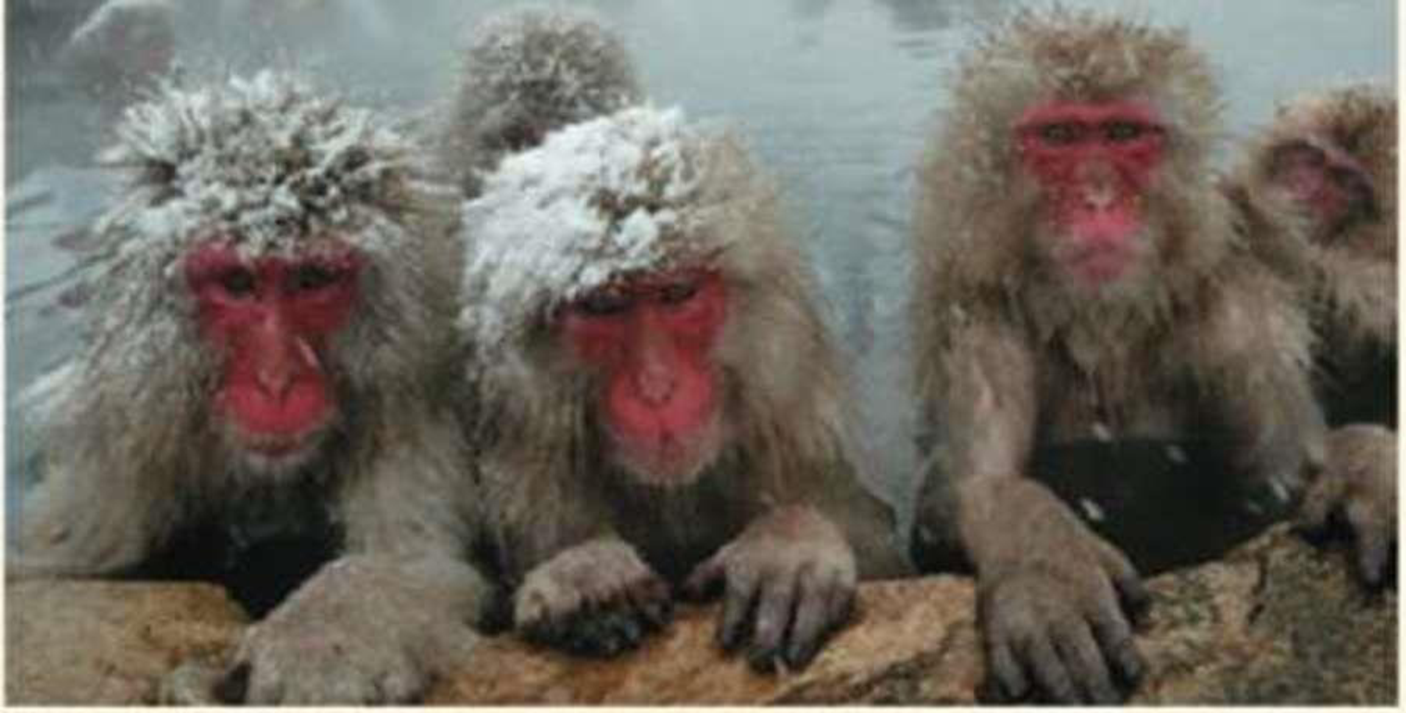
Campbell Biology: Australian And New Zealand Edition + Mastering Biology With Etext
11th Edition
ISBN: 9781488687075
Author: Lisa, A. Urry
Publisher: PEARSON
expand_more
expand_more
format_list_bulleted
Textbook Question
Chapter 40, Problem 13TYU

| 13. SYNTHESIZE YOUR KNOWLEDGE |
These macaques (Macaca fuscata) are partially immerseil in a hot spring in a snowy region of Japan. What are some ways that form, function, and behavior contribute to homeostasis for these animals?
Expert Solution & Answer
Trending nowThis is a popular solution!

Students have asked these similar questions
Explain in a small summary how:
What genetic information can be obtained from a Punnet square? What genetic information cannot be determined from a Punnet square?
Why might a Punnet Square be beneficial to understanding genetics/inheritance?
In a small summary write down:
Not part of a graded assignment, from a past midterm
Chapter 40 Solutions
Campbell Biology: Australian And New Zealand Edition + Mastering Biology With Etext
Ch. 40.1 - What properties do all types of epithelia share?Ch. 40.1 - VISUAL SKILLS Consider the idealized animal in...Ch. 40.1 - WHAT IF? Suppose you are standing at the edge of...Ch. 40.2 - MAKE CONNECTIONS How does negative feedback in...Ch. 40.2 - If you were deciding where to put the thermostat...Ch. 40.2 - Prob. 3CCCh. 40.3 - Prob. 1CCCh. 40.3 - Flowers differ in how much sunlight they absorb....Ch. 40.3 - Prob. 3CCCh. 40.4 - If a mouse and a small lizard of the same mass...
Ch. 40.4 - Prob. 2CCCh. 40.4 - Prob. 3CCCh. 40 - Prob. 40.1CRCh. 40 - Is it accurate to define homeostasis as a constant...Ch. 40 - Given that humans thermoregulate, explain why your...Ch. 40 - Why do small animals breathe more rapidly than...Ch. 40 - Level 1: Knowledge/Comprehension 1. The body...Ch. 40 - Prob. 2TYUCh. 40 - Consider the energy budgets for a human, an...Ch. 40 - Prob. 4TYUCh. 40 - Prob. 5TYUCh. 40 - Prob. 6TYUCh. 40 - Prob. 7TYUCh. 40 - Prob. 8TYUCh. 40 - EVOLUTION CONNECTION In 1847, the German biologist...Ch. 40 - SCIENTIFIC INQUIRY Eastern tent caterpillars...Ch. 40 - SCIENCE. TECHNOLOGY. AND SOCIETY Medical...Ch. 40 - WRITE ABOUT A THEME: ENERGY AND MATTER In a short...Ch. 40 - 13. SYNTHESIZE YOUR KNOWLEDGE These macaques...
Knowledge Booster
Learn more about
Need a deep-dive on the concept behind this application? Look no further. Learn more about this topic, biology and related others by exploring similar questions and additional content below.Similar questions
- Noggin mutation: The mouse, one of the phenotypic consequences of Noggin mutationis mispatterning of the spinal cord, in the posterior region of the mouse embryo, suchthat in the hindlimb region the more ventral fates are lost, and the dorsal Pax3 domain isexpanded. (this experiment is not in the lectures).a. Hypothesis for why: What would be your hypothesis for why the ventral fatesare lost and dorsal fates expanded? Include in your answer the words notochord,BMP, SHH and either (or both of) surface ectoderm or lateral plate mesodermarrow_forwardNot part of a graded assignment, from a past midtermarrow_forwardNot part of a graded assignment, from a past midtermarrow_forward
- please helparrow_forwardWhat does the heavy dark line along collecting duct tell us about water reabsorption in this individual at this time? What does the heavy dark line along collecting duct tell us about ADH secretion in this individual at this time?arrow_forwardBiology grade 10 study guidearrow_forward
arrow_back_ios
SEE MORE QUESTIONS
arrow_forward_ios
Recommended textbooks for you
 Biology (MindTap Course List)BiologyISBN:9781337392938Author:Eldra Solomon, Charles Martin, Diana W. Martin, Linda R. BergPublisher:Cengage Learning
Biology (MindTap Course List)BiologyISBN:9781337392938Author:Eldra Solomon, Charles Martin, Diana W. Martin, Linda R. BergPublisher:Cengage Learning Biology: The Dynamic Science (MindTap Course List)BiologyISBN:9781305389892Author:Peter J. Russell, Paul E. Hertz, Beverly McMillanPublisher:Cengage Learning
Biology: The Dynamic Science (MindTap Course List)BiologyISBN:9781305389892Author:Peter J. Russell, Paul E. Hertz, Beverly McMillanPublisher:Cengage Learning Biology 2eBiologyISBN:9781947172517Author:Matthew Douglas, Jung Choi, Mary Ann ClarkPublisher:OpenStax
Biology 2eBiologyISBN:9781947172517Author:Matthew Douglas, Jung Choi, Mary Ann ClarkPublisher:OpenStax Biology: The Unity and Diversity of Life (MindTap...BiologyISBN:9781305073951Author:Cecie Starr, Ralph Taggart, Christine Evers, Lisa StarrPublisher:Cengage Learning
Biology: The Unity and Diversity of Life (MindTap...BiologyISBN:9781305073951Author:Cecie Starr, Ralph Taggart, Christine Evers, Lisa StarrPublisher:Cengage Learning Concepts of BiologyBiologyISBN:9781938168116Author:Samantha Fowler, Rebecca Roush, James WisePublisher:OpenStax College
Concepts of BiologyBiologyISBN:9781938168116Author:Samantha Fowler, Rebecca Roush, James WisePublisher:OpenStax College

Biology (MindTap Course List)
Biology
ISBN:9781337392938
Author:Eldra Solomon, Charles Martin, Diana W. Martin, Linda R. Berg
Publisher:Cengage Learning

Biology: The Dynamic Science (MindTap Course List)
Biology
ISBN:9781305389892
Author:Peter J. Russell, Paul E. Hertz, Beverly McMillan
Publisher:Cengage Learning

Biology 2e
Biology
ISBN:9781947172517
Author:Matthew Douglas, Jung Choi, Mary Ann Clark
Publisher:OpenStax


Biology: The Unity and Diversity of Life (MindTap...
Biology
ISBN:9781305073951
Author:Cecie Starr, Ralph Taggart, Christine Evers, Lisa Starr
Publisher:Cengage Learning

Concepts of Biology
Biology
ISBN:9781938168116
Author:Samantha Fowler, Rebecca Roush, James Wise
Publisher:OpenStax College
MARINE ECOSYSTEM (Animation); Author: EarthPen;https://www.youtube.com/watch?v=-wrUr0esoI0;License: Standard YouTube License, CC-BY